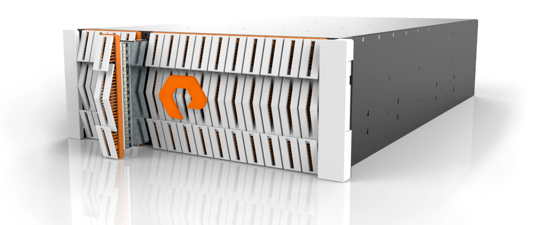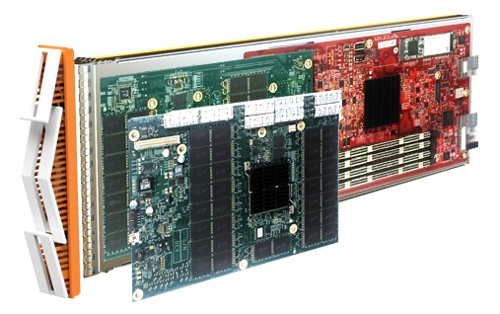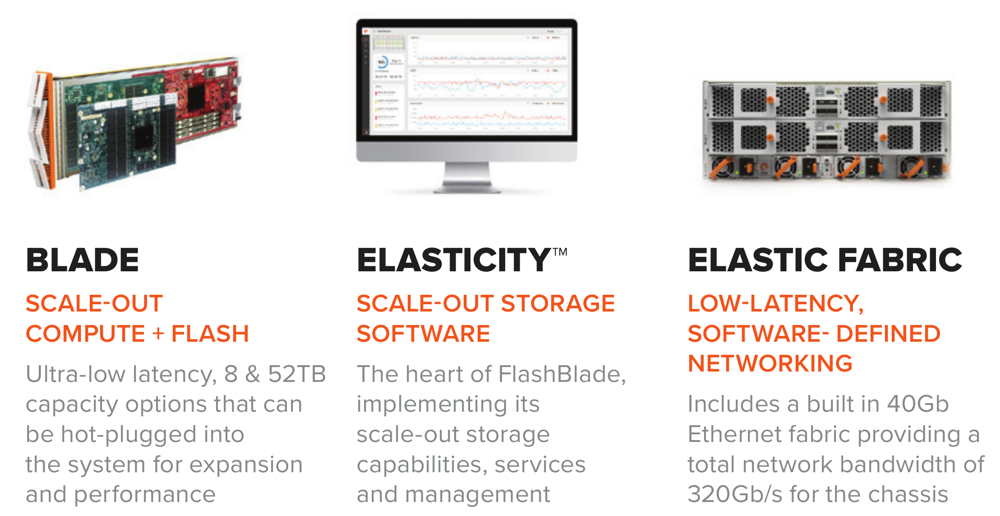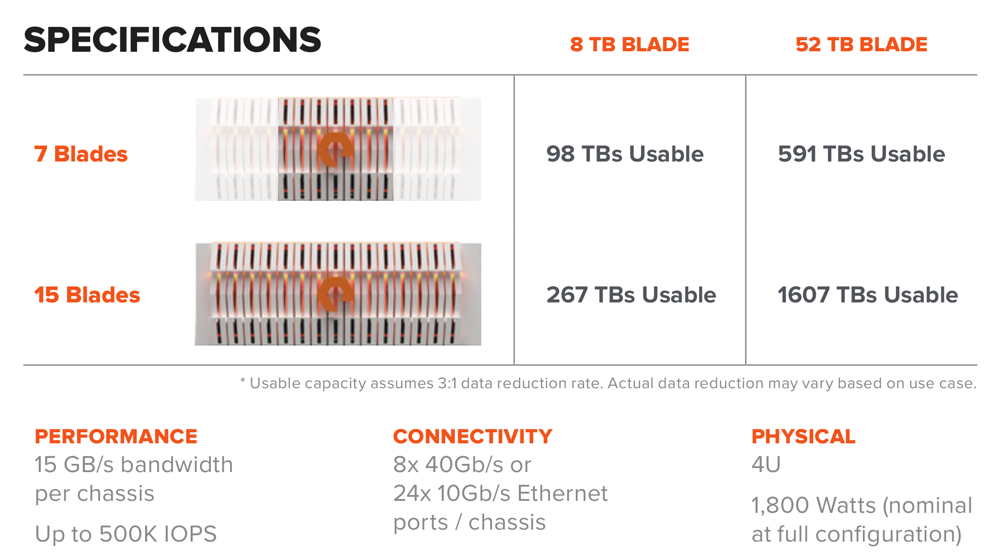Pure Storage FlashBlade Shipping in 8.8TB and 52TB Blade Capacities
With Elasticity 1.2 software
This is a Press Release edited by StorageNewsletter.com on January 30, 2017 at 2:53 pmPure Storage, Inc. announced that FlashBlade, the company’s second product built for performance unstructured workloads, is available and shipping in 8.8 and 52TB blade capacities with the Elasticity 1.2 software.

Modern engineers, scientists and developers seek a new type of storage platform – one that can deliver fast performance across a massive expanse of data and connect clients simply and easily. FlashBlade provides that platform without the complexity or cost of legacy or exotic systems.

FlashBlade, which was first announced in March 2016, has been in Directed Availability since July 2016, and has gained traction across industries and verticals – all driven by the expansion and analysis of mission-critical data. Today’s GA announcement enables FlashBlade to be sold by the company’s channel partners worldwide.
With the relentless digitization of the global economy, data is at the core of competitiveness and differentiation. Organizations have started investing heavily in both data science professionals and tools to mine value from data. Data-intensive storage workloads are thus proliferating – real-time and big data analytics, genomics sequencing, advanced analytics in professional sports, financial analysis, oil and gas exploration and large-scale online gaming platforms – with each driving a new and increasing set of storage requirements.

“More and more IT organizations are looking at big data analytics to help drive higher revenues, improve customer service, identify new market opportunities, and inform better business decisions. The workload requirements for big data analytics are not well met with traditional storage architectures, and in 2016 the first revenues were generated by a new all-flash array platform type – big data flash – specifically architected for these types of environments,” said Eric Burgener, research director, storage, IDC. “Big data flash platforms are optimized to handle very large unstructured data sets with high degrees of concurrency while delivering flash performance and reliability. FlashBlade from Pure Storage, already deployed across a number of different verticals, is one of the earliest entrants into this high growth new market, which IDC expects will drive $1.05 billion in revenues by 2020.”

Organizations have accelerated the transition from analyzing historical data in the classic batch mode towards real-time and iterative analytics, notably driven by the adoption of Apache Spark and similar technologies, as big data transforms to ‘big + fast’ data. Modern analytics, coupled with scalable high performance file and object storage, have become the fundamental building block to accelerate innovation, reach customers and prospects in real time, and drive informed decisions. Without data, organizations risk leaving money, productivity and competitive advantage on the table.
“FlashBlade helps Pure deliver on its core promise – to help customers in all industries gain advantage from their data on a massive scale. FlashBlade is not only optimized for the rapidly expanding world of unstructured data, but also designed to revolutionize the way organizations innovate with that data,” said Scott Dietzen, CEO, Pure. “Through the incredible work of our beta and directed availability customers, we’ve seen the potential of FlashBlade not only to alter the face of engineering and creative workloads, but to change what’s possible in medicine, science, and security.“
Improving personalized healthcare with genomics
With FlashBlade, genomics labs and research facilities can conduct secondary analysis workflow to sequence genomes, as well as filter, reassemble and align reads to construct a sequence. It also enables the conversion of data into base pairs and the computation of quality scores, and allows organizations to convert raw genomic data.
The ADAM/Big Data Genomics project, working in the UC Berkeley EECS department, builds healthcare tools and technologies that can be transferred from academia to clinical care. Researchers and graduate students interact with massive data sets as they look to make correlations within the data, which makes visualization a key to success. FlashBlade delivers the performance and speed required to run difficult, data-intensive visualizations as the data is set in three dimensions.
Once the research is complete and correlations have been established, those patterns and findings can be used by medical professionals to adjust clinical diagnostics in real-time. This allows patients to begin critical, life-saving treatments immediately with personalized care based on genetic predispositions.
“When our researchers want to visualize a pattern or interaction, it creates a significant tax on our storage systems. Visualizations inherently require so much data to run, that they are nearly impossible to run smoothly,” said Anthony D. Joseph, professor, core faculty member of UC Berkeley‘s Center for Computational Biology (CCB). “FlashBlade removes that roadblock for our researchers, which means our findings positively impact public health faster than ever before. If a doctor knows exactly which treatment to prescribe a patient based on that patient’s genetic makeup, that patient is going to recover sooner. It’s that simple.”
Adding competitive edge for championship teams
Analytics has had a profound impact on professional sports, as illustrated by the book and film Moneyball, and the subsequent trend of analytics-driven decision making across major league sports. Across professional sports, including baseball, football, hockey, basketball, motorsports and more, sports analytics and advanced statistics have become one of the most critical trends across professional athletics. From situational analysis and quality of competition to the dissection of athlete video, the data generated and used by professional sports franchises and organizations – much of which directly impacts personnel and organizational decisions – has grown exponentially over the past decade.
For high-performance workloads like real-time sensor data, player video or expansive statistical database management, FlashBlade is a fit. Simple to manage and in a compact 4U form factor, FlashBlade offers organizations with busy travel schedules and extensive set-up a mobile option for on-premises.
The Mercedes-AMG Petronas Motorsport Formula 1 team brings its arrays trackside from race to race, which act as a compact, mobile data center to store and process real-time data from nearly 250 sensors across each car.
“Formula One is, inherently, a mobile experience. Everything from the car, personnel, hospitality equipment and full IT infrastructure comes with us from city to city – and that includes our storage,” said Matt Harris, head, IT, Mercedes-AMG Petronas Motorsport. “The level of performance we expect from our storage is commensurate with what we expect from the car. It has to be the fastest to gain a competitive advantage. FlashBlade provides the high-performance infrastructure required to run real-time analytics platforms that help give us that championship edge.“
Reducing environmental impact through data
As they become powerful, computers can analyze the earth’s data at increasingly higher degrees of resolution. This allows scientists to pinpoint oil reservoirs, identify optimal points for least invasive entry, and provides important computer analysis into potential environmental leaks or hazards.
Prior to the start of a project, oil and gas companies engage engineering firms with a massive libraries of geophysical maps. Those firms analyze the location of the proposed project on behalf of oil and gas companies to ensure that any planned drilling, intrusion or excavation is done with a detailed understanding of what exists below the surface. For these firms, the challenge is to provide customers with that data as quickly and efficiently as possible to move the project forward.
“Drilling and modeling is a complex field of physics. The scientists who lead and design these projects are highly specialized, and they are busy. The less time they spend waiting on a computer, the faster their organizations make money,” said Par Botes, VP, FlashBlade, Pure. “The impact of fast but thorough analysis of earth data goes beyond quick delivery to customers – it means their projects will be safer both for their people, and for the planet.“
Better banking for Credit Unions with All-Flash infrastructure
For SaaS and cloud providers, all-flash infrastructure is a key differentiator in accelerating time to market, improving SLAs and opening up new customer opportunities. In financial services particularly, performance and reliability are the most critical requirements.
Today, many credit unions are still equipped with aging, legacy infrastructure. CUProdigy, Inc., a provider of cloud-based software for credit unions, delivers a Software-as-a-Service platform that allows credit unions to modernize by running all operations in the cloud – from desktops, servers, email, and file share to the mission-critical banking system itself.
In order to maximize the benefit of that transition, it was important to CUProdigy that its infrastructure and tools were modern through-and-through. Additionally, the company needed a solution that could support a high degree of mixed workloads without having to reconfigure or specifically designate the storage system for any particular type of workload. Enter FlashBlade.
“As a SaaS provider, our revenue is linked to scale – but so is our operating expense. We needed a solution that not only provided performance and reliability necessary to meet key SLAs for our customers, but one that would efficiently scale to meet the growing needs of our environment without driving cost through the roof,” said Xerex Bueno, CTO, CUProdigy. “The decision to move to an all-flash infrastructure has reduced our data center footprint. With FlashBlade we believe that the density and amount of customer information we can get per tile in our data center is the best possible. And, as a result of these significant efficiency gains, we are a better run company and deliver a better service to our customers today.”
FlashBlade is an elastic scale-out system that delivers all-flash performance to petabyte-scale data sets with overall economics comparable to legacy hybrid arrays. Optimized for high concurrency, high bandwidth, high IO/s and consistently low latency in a small, 4U form factor, it is equipped to handle the most demanding workloads generated by today’s performance applications. FlashBlade is simple to install, deploy and operate, which accelerates customer time to meaningful data analysis. Together, the FlashBlade and the FlashArray offer a complete platform for organizations to build their all-flash cloud and gain advantage from their data.
“We are extremely proud of the engineering team that has worked to deliver FlashBlade to the market against an extremely aggressive schedule – starting with the beta launch in March, through Directed Availability in July, through to an on-time completion in Q4,” said Par Botes, VP, FlashBlade, Pure. “We continue to work with, and take inspiration from, our customers as they use FlashBlade to accelerate their businesses and change the world – pushing us even harder to keep pace. The journey of driving innovation with FlashBlade is in its early stages, with much more to come – a road and a challenge that we welcome.“
“FlashBlade is breathing new life into a market that has been lacking in innovation for several years, that market being scale-out file storage,” said Chad Cardenas, president, Trace3, Inc. “Customers need a scale-out system that is not only simple but also equipped to handle high-performance workloads. We are proud to partner with Pure as they continue to blaze the trail for storage with FlashBlade.“













 Subscribe to our free daily newsletter
Subscribe to our free daily newsletter

